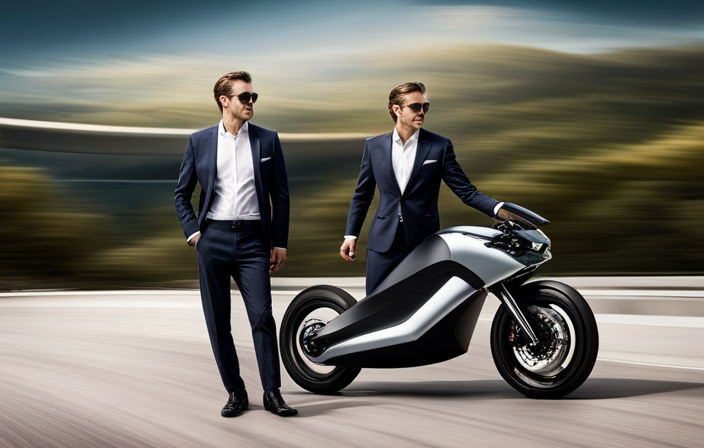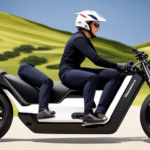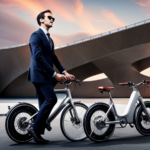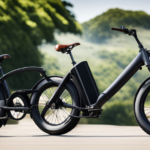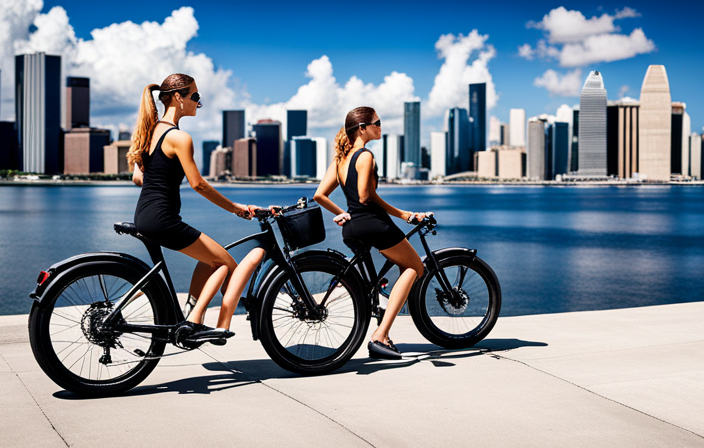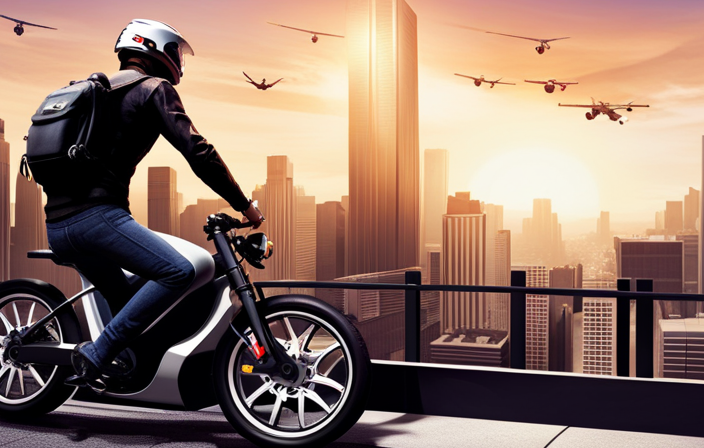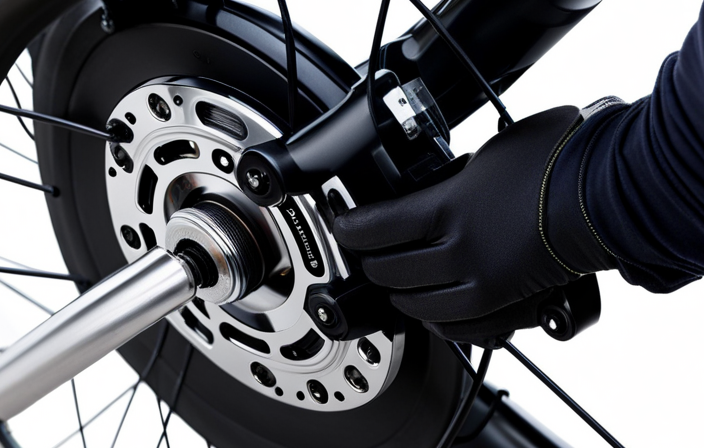Picture yourself starting a journey where the road extends ahead of you, inviting you to discover new horizons.
As an electric bike enthusiast, I have come to understand the importance of range – the distance an electric bike can travel on a single charge.
In this article, we will delve into the various factors that affect the range of an electric bike, from battery capacity and motor power to terrain and rider weight.
Join me as we unravel the mysteries of electric bike range and discover how to maximize our two-wheeled adventures.
Key Takeaways
- Riding speed and technique can significantly affect the range of an electric bike
- The Battery Management System (BMS) plays a crucial role in managing battery efficiency and providing real-time data on remaining capacity and estimated range
- Accessories and attachments can enhance the electric biking experience and provide convenient storage options
- Regular maintenance and tune-ups are essential for optimal performance and to ensure a smooth and worry-free journey with an electric bike.
Battery Capacity and Type
You may be wondering about the battery capacity and type of an electric bike. When it comes to electric bikes, the battery life and charging time are crucial factors to consider.
The battery capacity determines how far you can ride on a single charge, while the type of battery affects its overall performance and durability. Generally, electric bikes use lithium-ion batteries, which offer a good balance between weight, capacity, and lifespan.
The battery life can vary depending on factors such as the terrain, rider weight, and assist level. On average, electric bike batteries can last anywhere from 20 to 80 miles per charge. Charging time also varies, typically taking around 4 to 6 hours for a full charge.
Now, let’s move on to the next section about motor power and efficiency.
Motor Power and Efficiency
With its motor humming at full tilt, the electric bicycle becomes a lightning bolt, propelling riders forward with impressive speed and grace. The motor power and efficiency play a crucial role in determining the range of an electric bike. Higher motor power allows for faster acceleration and higher top speed, but it also consumes more energy. Efficiency, on the other hand, refers to how effectively the motor converts electrical energy into mechanical power. A more efficient motor will use less energy, thereby extending the bike’s range. To illustrate the impact of motor performance and energy consumption, consider the following table:
| Motor Power (Watts) | Efficiency (%) | Energy Consumption (Wh/km) |
|---|---|---|
| 250 | 80 | 15 |
| 500 | 85 | 18 |
| 750 | 90 | 22 |
| 1000 | 95 | 25 |
As we can see, higher motor power and efficiency generally result in higher energy consumption. However, it’s important to note that these figures can vary depending on factors such as rider weight, terrain, and riding style. Moving on to the next section about terrain and elevation changes, we’ll explore how these factors affect the range of an electric bike.
Terrain and Elevation Changes
Navigate your way through different terrains and elevation changes to unlock the full potential of your electric bicycle. The range of an electric bike can be greatly affected by the type of terrain you’re riding on. When considering trail difficulty, remember that the more challenging the trail, the more power your bike will need to overcome obstacles.
Steep hills, in particular, can have a significant impact on your electric bike’s range. The motor will have to work harder to climb these hills, which can drain the battery faster. However, with the right electric bike and proper gear shifting, you can conquer even the steepest of hills and still maintain a decent range.
Transitioning into the subsequent section about rider weight and riding style, it’s important to consider how these factors can further influence the range of your electric bike.
Rider Weight and Riding Style
When it comes to rider weight and riding style, how you pedal can make a significant difference in the distance you can travel on your e-bike. Research shows that a rider who pedals consistently and smoothly can increase their average speed by up to 20%.
This not only affects the overall range of the electric bike but also impacts the rider’s fitness level. Heavier riders may experience a slightly reduced range due to increased resistance, while lighter riders may achieve a longer range on the same bike.
Additionally, the design and construction of the bike frame can also play a role in the range. A sturdy and lightweight frame can contribute to better efficiency and performance.
Moving forward, let’s explore the impact of pedal assist levels on an electric bike’s range.
Pedal Assist Levels
Boost your riding experience to new heights by exploring the different pedal assist levels available on your e-bike. With pedal assist customization, you can fine-tune your electric bike to match your fitness level and desired level of exertion.
Here are four levels of pedal assist that you can choose from:
- Eco Mode: Provides a gentle boost, perfect for conserving battery power and extending your range.
- Normal Mode: Offers a balanced level of assistance, suitable for everyday commuting or leisurely rides.
- Sport Mode: Delivers a more powerful boost, ideal for tackling hilly terrains or when you want to amp up your workout.
- Turbo Mode: Gives you maximum assistance, allowing you to reach higher speeds effortlessly.
Customizing your pedal assist levels not only enhances your riding experience but also has an impact on your physical fitness. By adjusting the level of assistance, you can challenge yourself and gradually improve your stamina and strength.
As we transition into the subsequent section about weather conditions, it’s important to consider how pedal assist can affect your ride in different environmental scenarios.
Weather Conditions
With a variety of weather conditions to conquer, my e-bike becomes a trusty companion on my outdoor adventures, braving rain, wind, and sunshine alike.
When it comes to electric bike performance, weather conditions play a significant role. Rain and wet surfaces can reduce traction, making it essential to ride cautiously and adjust speed accordingly. Strong winds can create resistance, affecting the range and speed of the bike. On the other hand, sunny and pleasant weather conditions provide optimal conditions for riding, maximizing the electric bike’s range and efficiency.
As we transition to the next section about tire pressure and condition, it is important to note that weather conditions can also impact these factors, affecting the overall performance and safety of the bike.
Tire Pressure and Condition
Now that we’ve discussed the impact of weather conditions on the range of an electric bike, let’s shift our focus to another important factor: tire pressure and condition.
Maintaining optimal tire pressure is crucial for maximizing the range of your electric bike. By keeping the tires properly inflated, you reduce rolling resistance and increase efficiency.
Additionally, regularly inspecting the condition of your tires is essential. Check for any signs of wear and tear, such as cracks or bulges, and replace the tires if necessary. Neglecting tire maintenance can lead to decreased range and compromised safety.
To summarize, optimizing tire pressure and ensuring tire condition are key steps in maximizing the range of your electric bike. Speaking of maximizing range, let’s now explore how bike weight and design can impact its performance.
Bike Weight and Design
To improve your electric bike’s performance, consider the weight and design of your ride. The bike frame plays a crucial role in determining the overall weight and stability of the bike. A lighter frame will allow for easier maneuverability and a smoother ride. Additionally, a well-designed frame can enhance the aerodynamics of the bike, reducing drag and increasing efficiency. Another important factor to consider is the battery life. Opting for a lighter battery can help to reduce the overall weight of the bike, resulting in increased range. Furthermore, a well-designed battery placement can contribute to a more balanced and comfortable ride. Taking these factors into account when choosing an electric bike will ensure that you have a ride that is both efficient and enjoyable. In the next section, we will explore the impact of riding speed on the range of an electric bike.
Riding Speed
Get ready to feel the wind in your hair as you pedal faster and unleash the speed demon within. When it comes to riding an electric bike, your riding technique plays a crucial role in determining the range you can achieve.
To maximize your speed and range, it is important to adopt efficient pedaling techniques. Maintaining a steady and consistent speed will help conserve battery power and extend your range.
Additionally, practicing proper safety measures such as wearing a helmet, using hand signals, and obeying traffic rules will ensure a safe and enjoyable ride.
As we delve into the next section about the battery management system, it is essential to understand how your riding speed and technique affect the overall performance of your electric bike.
Battery Management System
Riding with a smooth and consistent speed will ensure that your battery is managed efficiently, allowing for a longer and more enjoyable journey. A crucial component in achieving efficient battery management is the Battery Management System (BMS). The BMS is responsible for monitoring the health and performance of the battery, ensuring optimal charging and discharging cycles. By constantly assessing the battery’s temperature, voltage, and current levels, the BMS can prevent overcharging, over-discharging, and overheating, thus prolonging the battery’s lifespan. This monitoring capability also helps alleviate range anxiety, as it provides real-time data on the battery’s remaining capacity and estimated range. To better understand the importance of battery health monitoring and its impact on range, refer to the table below:
| Battery Health | Remaining Capacity | Estimated Range |
|---|---|---|
| Excellent | 100% | 100 miles |
| Good | 80% | 80 miles |
| Fair | 60% | 60 miles |
| Poor | 40% | 40 miles |
With a well-managed battery and a clear understanding of its capabilities, you can confidently plan your rides without range anxiety. Now, let’s explore the next section about accessories and attachments.
Accessories and Attachments
Enhance your electric biking experience by adding accessories and attachments that cater to your specific needs and style, making every ride a true reflection of your personality.
When considering accessories for your electric bike, it is essential to ensure compatibility with your bike’s design and specifications. Look for accessories that seamlessly integrate with your bike’s frame, such as baskets or racks that provide convenient storage solutions for your belongings.
Whether you need to carry groceries, a backpack, or even a pet, there are various attachment options available to suit your needs. Additionally, consider accessories that enhance safety, such as lights, mirrors, or fenders. These add-ons not only make your ride safer but also complement the overall aesthetics of your electric bike.
As we explore maintenance and tune-ups, it is important to keep in mind that regular servicing is vital for optimal performance.
Maintenance and Tune-Ups
Maintaining and tuning up your electric bike is crucial for ensuring a smooth and worry-free journey, allowing you to fully enjoy the freedom and exhilaration of exploring the open road.
To keep your electric bike in optimal condition, there are a few maintenance tips to keep in mind. Regularly inspecting the tires for wear and tear and ensuring proper tire pressure is essential for a safe and efficient ride. Additionally, checking and tightening all bolts and screws, especially those on the handlebars and seat, is important to prevent any loose parts during your ride. Common issues to look out for include loose chains, misaligned brakes, and worn brake pads. By addressing these issues promptly, you can prevent further damage and ensure a reliable ride.
Moving on to the subsequent section about the age and condition of the battery, it is important to understand how your battery’s age and condition can affect the range of your electric bike.
Age and Condition of the Battery
To get the most out of your exhilarating adventures, it’s important to understand how the age and condition of your battery can impact your journey.
The battery life of an electric bike is influenced by its age and condition. As the battery gets older, its capacity to hold a charge diminishes, resulting in a shorter range. Additionally, the overall condition of the battery plays a significant role in determining its performance. A well-maintained battery will provide a longer range compared to one that is poorly maintained.
It is crucial to regularly check the battery’s health and ensure it is in optimal condition. Furthermore, the charging time of the battery can also affect the range of an electric bike. Charging the battery fully and avoiding frequent partial charges can help maximize the range.
Understanding the age, condition, and charging habits of your battery will allow you to plan your adventures accordingly, ensuring you have the longest and most enjoyable rides possible.
Now, let’s delve into the next section about battery charging habits.
Battery Charging Habits
When it comes to your electric bike’s battery, it’s crucial to develop good charging habits that will optimize its performance and ensure you have the best adventures possible.
To maximize battery lifespan, it is recommended to charge it regularly, ideally after each ride, regardless of the remaining charge. Avoid fully depleting the battery before charging, as this can put unnecessary strain on the cells.
Additionally, it is important to avoid overcharging the battery, as this can lead to reduced capacity over time. Charging time can vary depending on the battery’s capacity and the charger used, but in general, it takes around 4-6 hours for a full charge.
By following these charging habits, you can extend the life of your battery and enjoy long rides without worrying about running out of power.
As we move on to testimonials and reviews from other riders, you will see how these charging practices have greatly enhanced their electric biking experience.
Testimonials and Reviews from Other Riders
Discover the stories of fellow riders and their exhilarating journeys powered by the incredible freedom of electric biking.
As an electric bike enthusiast, I’ve had the pleasure of reading and hearing numerous testimonials and reviews from other riders. One aspect that stands out in these testimonials is the performance comparison between electric bikes and traditional bicycles.
Riders consistently mention the impressive speed and acceleration of electric bikes, allowing them to easily navigate hilly terrains and reach their destinations faster.
Another key point that riders highlight is the long-term durability of electric bikes. Many riders have shared their experiences of using electric bikes for several years without any major issues, proving the reliability and sturdiness of these bikes.
These testimonials and reviews provide valuable insights into the range and capabilities of electric bikes, making them a compelling choice for those seeking an electrifying biking experience.
Frequently Asked Questions
Can an electric bike be used for long-distance commuting?
Yes, an electric bike can be used for long-distance commuting. Compared to a traditional bike, the electric bike offers the benefits of easier pedaling, reduced fatigue, and a higher average speed, making it suitable for longer commutes.
How does the range of an electric bike compare to a regular bicycle?
Commuting with an electric bike provides the convenience of a regular bike with added benefits. Imagine effortlessly cruising past traffic while still getting a good workout. The range of an electric bike far surpasses that of a regular bike, making it perfect for long-distance commuting.
Are there any factors that can significantly reduce the range of an electric bike?
Factors affecting electric bike range include terrain, wind resistance, weight of the rider and cargo, tire pressure, and temperature. Tips to maximize range include maintaining proper tire pressure, reducing weight, pedaling, and avoiding excessive acceleration and braking.
Can the range of an electric bike be extended with additional batteries?
Exploring alternative methods to extend the range of an electric bike, such as efficiency improvements, can optimize energy usage. By implementing these strategies, riders can increase their bike’s range without the need for additional batteries.
Is it possible to upgrade the battery of an electric bike to increase its range?
Yes, it is possible to upgrade the battery of an electric bike to increase its range. By upgrading the battery, you can achieve a greater distance on a single charge, allowing for longer rides without the need for recharging.
Conclusion
In conclusion, the range of an electric bike can vary greatly depending on several factors. Battery capacity and type, motor power and efficiency, terrain and elevation changes, rider weight and riding style, pedal assist levels, maintenance and tune-ups, age and condition of the battery, and battery charging habits all play a role in determining the range of an electric bike.
One interesting statistic to note is that on average, electric bikes have a range of 20-50 miles per charge, with some high-end models reaching up to 100 miles.

